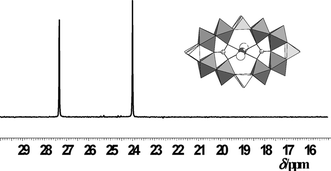Template synthesis of {(MoV2O4)(O3PCH2PO3)}n clusters (n = 3, 4, 10): solid state and solution studies
Abstract
The influence of three exogenous

* Corresponding authors
a
Laboratoire de Physico-Chimie des Solides Moléculaires, Institut Lavoisier, UMR 8637, Université de Versailles Saint-Quentin, 45 Avenue des Etats-Unis, 78035 Versailles Cedex, France
E-mail:
mialane@chimie.uvsq.fr
The influence of three exogenous

 Please wait while we load your content...
Something went wrong. Try again?
Please wait while we load your content...
Something went wrong. Try again?
C. D. Peloux, A. Dolbecq, P. Mialane, J. Marrot and F. Sécheresse, Dalton Trans., 2004, 1259 DOI: 10.1039/B401250J
To request permission to reproduce material from this article, please go to the Copyright Clearance Center request page.
If you are an author contributing to an RSC publication, you do not need to request permission provided correct acknowledgement is given.
If you are the author of this article, you do not need to request permission to reproduce figures and diagrams provided correct acknowledgement is given. If you want to reproduce the whole article in a third-party publication (excluding your thesis/dissertation for which permission is not required) please go to the Copyright Clearance Center request page.
Read more about how to correctly acknowledge RSC content.
 Fetching data from CrossRef.
Fetching data from CrossRef.
This may take some time to load.
Loading related content
